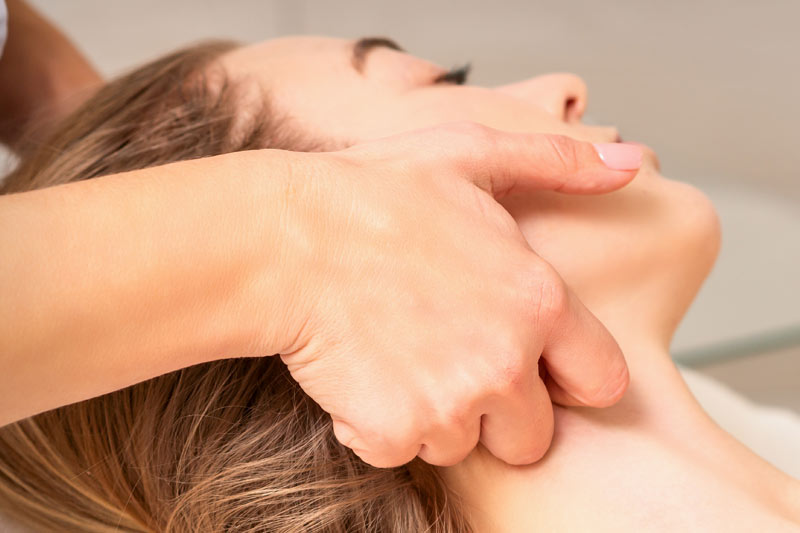Massage is a natural healing method for sore, tight, and painful muscles. Massage therapists have developed various techniques for different health concerns, and among the more unusual ones is massage of the mouth or intraoral massage.
This article explains how intraoral massage works and what conditions it helps manage.

What Is an Intraoral Massage?
Intraoral massage is a form of manual therapy that involves massaging the muscles inside the mouth. It is used in medicine to relieve discomfort and pain from injury, stiff jaw, TMJ dysfunction, tinnitus, dental work, emotional stress, and more. It is also gaining popularity as a cosmetic treatment (known as buccal massage) because it helps reduce aging signs.
Intraoral Massage Benefits
The benefits of intraoral massage include:
1. Reduced Pain
We use jaw muscles daily for various activities, from chewing and swallowing, to talking and laughing. When overworked, they become stiff and painful. Other factors contributing to pain in this area include stress, bruxism (teeth grinding), acute trauma, and TMJ (temporomandibular joint) dysfunction. Left untreated, jaw pain can spread to other areas, causing neck pain and migraines. Intraoral massage is an effective treatment for jaw pain and associated disorders.
2. Increased Jaw Flexibility and Range of Motion
Tight jaw muscles cause limited movement of the jaw and mouth. Intraoral massage warms the muscles, relaxing and loosening muscle fibers. Their increased elasticity helps extend the range of motion in the oral cavity, reducing discomfort and pain. One clinical study showed an increase in maximal jaw opening from 1.2 in to 1.5 in.
3. Increase in Neck Range of Motion
Intraoral massage typically involves massaging the surrounding areas, including the neck and shoulders. It reduces muscle tightness (hypertonicity), increasing the range of motion in the neck.
4. Decline in Tension and Stress
Massaging the knots and trigger points in the mouth loosens the muscles and ligaments. It promotes relaxation and helps the patient feel relief from muscle tension and stress.
5. Improved Circulation
Massaging muscles and ligaments helps improve circulation and blood flow, increasing the delivery of nutrients and oxygens to cells and helping to drain out toxins and waste. This benefits the patient’s overall tissue health.
6. Rejuvenated Skin in the Lower Facial Area
Intraoral massage can be an effective anti-aging treatment. Increasing circulation and relaxing the muscles that pull down on the jawline provides various cosmetic benefits, from reduced puffiness and lifted skin to a smoother and clearer complexion.
Note: Learn how to rejuvenate aging skin with anti-aging treatments, quality skin care, and lifestyle changes.
What Can You Expect During Intraoral Massage?
The therapy starts with a warm-up. The provider massages the masseter muscles to relax them before the intraoral massage. They clean the area and put on medical gloves to avoid infection.
Note: Learn how masseter Botox can help you reduce teeth grinding, remove associated pain, and contour the jawline.
The providers use different techniques during the intraoral massage. Some use the thumbs and index fingers to massage the interior of the mouth and other fingers to massage the outside area. Other providers use the thumb on the outside and the index finger on the inside, applying pressure and compressing target muscles, holding and releasing them in steady intervals.
The provider modifies the pressure during the treatment based on the patient’s comfort level.
After the intraoral massage, the provider massages the patient’s face, neck, shoulders, and scalp. The whole treatment lasts 30-60 minutes.
Will You Feel Pain During Intraoral Massage?
Massaging stiff and tender muscles can be uncomfortable in the beginning, especially when the provider works on painful trigger points. Experienced massage therapists start with light strokes and then intensify the pressure.
Some patients feel short bursts of pain, but most report feeling only discomfort at first, followed by relaxation.
Intraoral Massage Results
Intraoral massage provides immediate relief from muscle tension and pain. To improve other conditions, such as limited range of neck and jaw movement, chronic pain, and premature skin aging, patients need a series of treatments.
Providers often recommend an initial set of five to ten weekly or bi-weekly sessions, followed by maintenance treatments once a month. The number and frequency of treatments are unique to each patient and depend on the severity of their condition.
Intraoral Massage Aftercare
Your intraoral massage therapist may advise you to follow these aftercare tips to ensure optimal results and minimize discomfort:
- Perform mouth, jaw, head, and neck exercises according to a given exercise sheet.
- Perform self-massage according to given instructions.
- Alternate warm and cold compresses.
- Decrease emotional stress.
- Drink plenty of water.
- Avoid using the treated muscles excessively.
If tightness and pain in the treatment area increase and persist for more than three days, contact your medical provider.
Intraoral Massage Cost
Intraoral massage prices range depending on the patient’s needs and the provider’s location and expertise.
At Vibrant Skin Bar, our holistic specialists provide a Lymphatic Lift at $199. It combines intraoral massage with lymphatic drainage to improve skin tone and texture, reduce muscle tension, and decrease stress.
Conclusion
Intraoral massage can be a useful tool for reducing pain, improving oral function, and promoting overall health and skin glow. Make sure to schedule the treatment with a qualified medical provider for maximum safety and to achieve the therapy’s full benefits.


